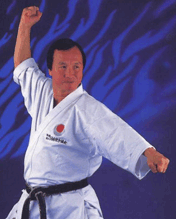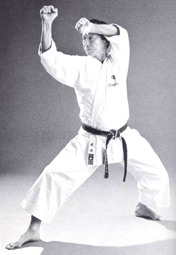![]()
 |
Karate kata are sequences of basic, intermediate and advanced techniques arranged into set orders and patterns. The closest examples or equivalents of the Karate kata in other activities or sports are shadow boxing, dance routines and the floor routines in gymnastics. The name kata is a Japanese term translated as mold, model, style, form or shape.
Each kata has it’s own character. Some kata are heavy and powerful whereas others are far more graceful and flowing in their nature. Some kata however, contain a mixture of both and each kata has it’s own unique timing. The 26 JKA shotokan kata are all individually named and given their own personality. In some cases, the source of the name is obvious. In others, the name of the kata can only be guessed at from the kanji that their identity was originally written in.
 |
Heian Kata
On the island of Okinawa, this group of kata were originally called the 'Pinan’ kata. The name Heian was given to them by Sensei Gichin Funokoshi and is most commonly interpreted as meaning 'Peaceful Mind’. The Heian kata are named in a fashion that indicates their level of difficulty, i.e. one to five. With the exception of the Tekki kata, the other Shotokan kata are not named using such a numerical system.
Tekki Kata
This group of three kata were originally called the Naihanchi kata. Once again this name was replaced by Funokoshi Sensei and changed to Tekki. The name Tekki is taken from the character 'Tetsu’ meaning iron or steel and 'Ki’ meaning to ride a horse or simply knight. One possible translation of the name Tekki is 'Iron Knight’.
Dai and Sho Kata
The Japanese kanji (characters) for Dai and Sho simply translate as 'Big’ and 'Small’. Despite a common misconception, Dai kata are not anymore or any less advanced than their Sho versions. Despite the translation of big and small, the Gojushiho kata are reversed. The 'dai’ version of these two kata is actually smaller than that of 'Sho’.
Common Kata Terminology
Rei - Bow
Yoi - Ready position
Yasume - Return to Yoi
Naore - Relax
Enbusen - The invisible performance line on which the kata is performed.
Kiai - Focus point in the kata where the Karate-Ka shouts.
Please select from the list below the Kata you wish to view
![]()
| |
Heian Shodan (Peaceful Mind - Level 1) 21 movements, Kiai on movements 9 and 17 |
| |
Heian Nidan (Peaceful Mind - Level 2) 26 movements, Kiai on movements 11 and 26 |
| |
Heian Sandan (Peaceful Mind - Level 3) 20 movements, Kiai on movements 10 and 20 |
| |
Heian Yondan (Peaceful Mind - Level 4) 27 movements, Kiai on movements 13 and 25 |
| |
Heian Godan (Peaceful Mind - Level 5) 23 movements, Kiai on movements 12 and 19 |
| |
Tekki Shodan (Iron Horse (Knight) - Level 1) 29 movements, Kiai on movements 15 and 29 |
| |
Tekki Nidan (Iron Horse (Knight) - Level 2) 24 movements, Kiai on movements 16 and 24 |
| |
Tekki Sandan (Iron Horse (Knight) - Level 3) 36 movements, Kiai on movements 16 and 36 |
| |
Bassai Dai (To penetrate a fortress) 42 movements, Kiai on movements 19 and 42 |
 |
Kanku Dai (To look at the sky) 65 movements, Kiai on movements 15 and 65 |
 |
Enpi (Flight of the swallow) 37 movements, Kiai on movements 15 and 36 |
 |
Jion (Named after the temple Jion-Ji) 47 movements, Kiai on movements 17 and 47 |
 |
Jitte (Ten Hands) 24 movements, Kiai on movements 13 and 24 |
 |
Hangetsu (Half Moon) 41 movements, Kiai on movements 11 and 40 |
| |
Gankaku (Crane standing upon a rock) 42 movements, Kiai on movements 28 and 42 |
![]()
 |
Bassai Sho (To penetrate a fortress- Minor) 27 movements, Kiai on movements 17 and22 |
| |
Kanku Sho (To look at the sky - Minor) 47 movements, Kiai on movements 6 and 47 |
 |
Chinte (Incredible Hands) 32 movements, Kiai on movements 28 and 32 |
| |
Nijushiho (24 Steps) 33 movements, Kiai on movements 18 and 32 |
| |
Wankan (Kings Crown) 25 movements, Kiai on movement 25 |
| |
Unsu (Hands in the clouds) 48 movements, Kiai on movements 38 and 48 |
| |
Gojushiho Sho (54 Steps – Minor) 65 movements, Kiai on movements 57 and 64 |




 Tweets by @456791084064976896
Tweets by @456791084064976896


